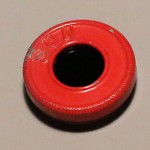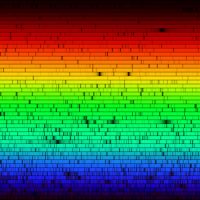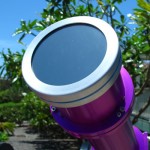I though these things were gone!

What are we discussing? Eyepiece style solar filters that screw into the threads on the bottom of the eyepiece, not at the front of the telescope like proper solar filters.
I actually have one of these things, found in a kit of equipment I was given. A bright red and very cheap pot metal casting with a small glass filter. I have never attempted to actually use it, I keep it as a example of the bad and the ugly. It is a vintage bit of gear, the type that was included with inexpensive Japanese refractors of the 60’s and 70’s, sized to be used with the small 0.965″ eyepieces of the era.

Given that the risk you are taking involves irreplaceable eyesight, this is very serious.
As I looked about I noted that there were quite a few of these filters available from numerous different sellers. I also noted that EBay does not have an obvious way to report a potentially dangerous product.
A Question of Energy
The first issue is energy… Remember the little kid with the magnifying glass and the ants? Ever burn paper with a magnifying glass? There are over 1,000 watts of energy in every square meter of sunlight, even a small fraction of that is enough to burn. One of the primary purposes of a telescope is to gather and concentrate energy. If you a concentrating the energy of a faint star or distant galaxy, this makes it brighter and more visible. The Sun is not faint.
Even a modest 60mm refractor telescope can gather about three watts, enough to easily burn paper, melt plastic, or permanently damage an eye. A common six-inch or 150mm newtonian? Now you can concentrate over 17 watts, about the same power as a soldering iron.
Solar filters either have to reflect or absorb this energy to reduce the amount reaching the eyepiece to a safe level. As such you will generally find them mounted to the front of the telescope, to reduce the amount of energy entering the optics, before it becomes concentrated. Standard glass or film solar filters reflect 99.999% of the light, allowing only a tiny percent to enter the optics.
The eyepiece filter sold on EBay are absorption filters, that excess energy not allowed through is absorbed by the filter. Such a filter is going to get hot… Very hot.
As the filter gets hot it can easily be damaged. In the process damaging your telescope, or worse. If the filter glass cracks in the heat it may allow unfiltered light through to your eye.
In proper operation the filter and eyepiece it is screwed into can get very hot. If the telescope is slightly off-target, all of that energy is going to be concentrated some part of the telescope near the focuser, possibly something that can be damaged or burn. The inexpensive telescopes on the market today include a lot of plastic parts, including the focuser.
Bottom line… Minor damage? You can burn paint and melt plastic around the eyepiece and focuser of the telescope. How much greatly depends on the size of the telescope, the danger goes up with larger apertures. Worst case? Permanent eye-damage faster than you can blink.
A Question of Wavelength
The second issue is wavelength coverage… Much of the damaging energy in sunlight is invisible, hidden from our sight in the infrared part of the solar spectrum. The near infrared section of the spectrum passes through normal glass optics just fine.

What is the standard? Yes there is a test standard for solar filters, ISO 12312-2:2015, Eye and face protection — Sunglasses and related eyewear — Part 2: Filters for direct observation of the sun. Any filter should conform with this specification.
What Now?
As for the EBay filters? Not much I can do except rant about them a bit here on DarkerView. I could report the seller, but the products will just pop up again on some other seller’s listing.
At least one EBay seller was aware of the possible danger, placing several safety notes in the listing. “Please don’t use it over 15 seconds one time, or it will hurt your eyes!” is in the listing in large red print… No kidding! The listing goes on to say, also in a big red font, “Kindly Reminder: Please use it with Baader Solar Film Sun Filter to Protect your eyes!”… If you use Baader film you do not need this thing!
What do you Use?

The more rugged glass filters are not very expensive either, around $50 to $90 for smaller telescopes. These offer a nice color balanced image in a filter that will last for many years.
OK… I will get off my soapbox now.


I ran across these dangerous filters just a few days ago (it’s 2/28/2019) on ebay. I quickly saw that there was no easy or accurate way to report them. So after searching I found a contact phone number – but again, there were no accurate categories to choose from. Eventually I was routed to an actual person who also figured out that there was no on-line way to report the items. So he put me in touch with someone who could take the report. I gave him the link to an AAS web page (https://eclipse.aas.org/eye-safety/optics-filters) that describes how dangerous these filters are. The ebay listings I saw all came from China but anyone could sell them. Like you, I didn’t think they were still available. It will be interesting to see if ebay actually does anything about them. Thanks for helping make people aware of this problem. It is scary to think that people unfamiliar with the danger could use these things and be blinded. In the 50s and 60s, people may not have been aware of the danger but there is no excuse today.
I checked a day or two after I contacted ebay and I only saw one seller selling eyepiece solar filters. (The seller recognized the danger – at least somewhat. They recommended only looking through the filter for a few seconds! Obviously this does not mitigate the risk,) I checked just a few minutes ago and I still see eyepiece solar filters for sale on ebay. There is still no ebay website link to report dangerous products on ebay.